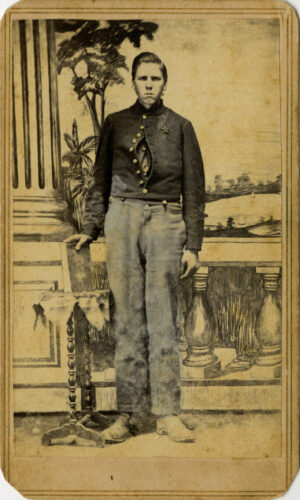Exploring Old Photographs: Cartes de Visite

Many people have old photographs, stored in a box or an old album, of long-ago relatives. Over the next few months, we’ll feature different types of photographs on paper that were popular in the nineteenth and early twentieth centuries and will also provide some tips for dating those old photos. We’ll start with cartes de visite (also called “cartes” or “card photographs”), which were the first mass-produced paper photographs.

The carte de visite format was patented by French photographer André Disdéri in 1854; it was so named because the size was based on a standard visiting card (about 2½ x 4 inches). With earlier photographic formats such as daguerreotypes and tintypes, each photo was one-of-a-kind; there was no way to easily print multiple copies of an image. Disdéri solved this problem by developing a camera with multiple lenses, which allowed multiple negatives to fit on a single glass plate. And unlike earlier processes where the image was developed on glass or metal, cartes de visite were developed on paper. The finished images could easily be cut apart, glued to cardstock, and sold inexpensively.
Disdéri’s innovations not only made photographic portraits affordable for the middle class, but also started a collecting craze that the press dubbed “cartomania” Cartes de visite became the nineteenth-century version of selfies; due to the low cost, people could purchase multiple copies of a photo and share them with friends and relatives nearby or across the country. An estimated 300 to 400 million cartes de visite were produced each year during the 1860s. Cartes may also have played a role in presidential politics; a portrait of Abraham Lincoln by renowned photographer Matthew Brady was printed in massive quantities in carte de visite format ahead of the 1860 election.
Cartes de visite also influenced (and were influenced by) society. The Civil War increased the demand for photos as soldiers left home to join the fight. People began to collect not just portraits of friends and family, but also portraits of celebrities (Britain’s Queen Victoria was a favorite) and illustrations of famous artworks. The first photo albums were created to store and display cartes de visite; often, the albums themselves were works of art.

Because cartes de visite were produced for half a century, it can sometimes be difficult to determine when a specific photo was created. Here are some tips:
- Early cardboard mounts were thin; later cartes de visite used increasingly thicker mounts. Mounts from the 1850s-1860s usually had square corners; mounts with rounded corners began to appear in the 1870s.
- Factory-printed borders on the front of the cards (generally two gold lines, but sometimes other colors) first appeared in 1863. Borders in the 1870s were generally a single line.
- Cartouche frames (intricately decorated cards with an oval cutout for the photograph) and hand-tinted cartes de visite were popular in the 1860s but became rare by the end of the decade.
- Oval-shaped images (created by placing a piece of cardboard with an oval cutout over a rectangular image) were popular in the 1870s. The cardboard ensured that only the oval portion of the photo was developed.
- Fashion can be helpful when dating photos; women’s hair and dress, as well as men’s facial hair and neckwear, can provide clues.
We’ll share more information about old photos, including cabinet cards and real photo postcards, in future blog posts!
Thank you to Stephanie Michaels, Research and Catalog Services Librarian at the State Library of Ohio, for this week’s post!



Leave a Reply
You must be logged in to post a comment.